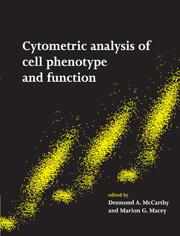Book contents
- Frontmatter
- Contents
- List of contributors
- List of abbreviations
- 1 Principles of flow cytometry
- 2 Introduction to the general principles of sample preparation
- 3 Fluorescence and fluorochromes
- 4 Quality control in flow cytometry
- 5 Data analysis in flow cytometry
- 6 Laser scanning cytometry: application to the immunophenotyping of hematological malignancies
- 7 Leukocyte immunobiology
- 8 Immunophenotypic analysis of leukocytes in disease
- 9 Analysis and isolation of minor cell populations
- 10 Cell cycle, DNA and DNA ploidy analysis
- 11 Cell viability, necrosis and apoptosis
- 12 Phagocyte biology and function
- 13 Intracellular measures of signalling pathways
- 14 Cell–cell interactions
- 15 Nucleic acids
- 16 Microbial infections
- 17 Leucocyte cell surface antigens
- 18 Recent and future developments: conclusions
- Appendix
- Index
- Plate section
2 - Introduction to the general principles of sample preparation
Published online by Cambridge University Press: 06 January 2010
- Frontmatter
- Contents
- List of contributors
- List of abbreviations
- 1 Principles of flow cytometry
- 2 Introduction to the general principles of sample preparation
- 3 Fluorescence and fluorochromes
- 4 Quality control in flow cytometry
- 5 Data analysis in flow cytometry
- 6 Laser scanning cytometry: application to the immunophenotyping of hematological malignancies
- 7 Leukocyte immunobiology
- 8 Immunophenotypic analysis of leukocytes in disease
- 9 Analysis and isolation of minor cell populations
- 10 Cell cycle, DNA and DNA ploidy analysis
- 11 Cell viability, necrosis and apoptosis
- 12 Phagocyte biology and function
- 13 Intracellular measures of signalling pathways
- 14 Cell–cell interactions
- 15 Nucleic acids
- 16 Microbial infections
- 17 Leucocyte cell surface antigens
- 18 Recent and future developments: conclusions
- Appendix
- Index
- Plate section
Summary
Introduction
When collecting and preparing samples for cytometric analysis, it is essential to use a protocol that enables the aims of the investigation to be fulfilled, because if samples are handled wrongly at the start, there is usually nothing that can be done later to remedy the situation. For many studies it may be possible to use, or to modify, an existing protocol; for others it may be necessary to devise a new one. In this chapter, the general principles relevant to collecting and preparing samples are discussed and some protocols described. Most were devised and validated using flow cytometry, but they should also be largely applicable to the newer technique of laser scanning cytometry.
Factors affecting the choice of preparation procedure
The key variables in any cytometric study are:
the nature of the sample material and of the cells to be studied
the cellular component(s) or molecule(s) that is(are) to be assayed
the label(s)/probe(s) that is(are) to be used, and hence the signal(s) that is(are) to be detected.
All of these factors must be taken into account when considering how best to collect and prepare samples. A protocol that is satisfactory for one particular combination may not be suitable if applied to a diVerent type of sample or if used to assay a diVerent component.
The sample material and cells to be studied
Flow cytometers analyse the fluorescent and scattered light arising from cells illuminated in suspension, whereas laser scanning cytometers analyse the same parameters arising from cells illuminated on a microscope slide.
Information
- Type
- Chapter
- Information
- Cytometric Analysis of Cell Phenotype and Function , pp. 15 - 44Publisher: Cambridge University PressPrint publication year: 2001
Accessibility standard: Unknown
Why this information is here
This section outlines the accessibility features of this content - including support for screen readers, full keyboard navigation and high-contrast display options. This may not be relevant for you.Accessibility Information
- 1
- Cited by
